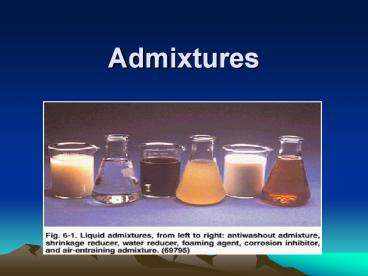Admixtures - PowerPoint PPT Presentation
Title:
Admixtures
Description:
Admixtures are those ingredients in concrete other than Portland cement, water, and aggregates that are added to the mixture immediately before or during mixing ... – PowerPoint PPT presentation
Number of Views:915
Avg rating:3.0/5.0
Title: Admixtures
1
Admixtures
2
Admixtures are those ingredients in concrete
other than Portland cement, water, and aggregates
that are added to the mixture immediately before
or during mixing (Fig. 6-1). Admixtures can be
classified by function as follows
3
- 1. Air-entraining admixtures2. Water-reducing
admixtures 3. Plasticizers4. Accelerating
admixtures5. Retarding admixtures6.
Hydration-control admixtures
4
- 7. Corrosion inhibitors
- 8. Shrinkage reducers
- 9. Alkali-silica reactivity inhibitors
- 10. Colouring admixtures
- 11. Miscellaneous admixtures such workabil-ity,
bonding, dampproofing, permeability reducing,
grouting, gas-forming, and pumping admixtures
5
The major reasons for using admixtures are
- 1. To reduce the cost of concrete
construction2. To achieve certain properties in
concrete more effectively than by other means3.
To maintain the quality of concrete during the
stages of mixing, transporting, placing, and
curing in adverse weather conditions4. To
overcome certain emergencies during concreting
operations
6
Air-Entraining Admixtures
- used to purposely introduce and stabilize
microscopic air bubbles in concrete.
Air-entrainment will dramatically improve the
durability of concrete exposed to cycles of
freezing and thawing (Fig. 6-2). Entrained air
greatly improves concrete's resistance to surface
scaling caused by chemical deicers
7
- The primary ingredients used in air-entraining
admixtures are salts of wood resin (Vinsol
resin), synthetic detergents, salts of petroleum
acids, etc. - See Table 6-1 p.106 in the text for more details.
8
Water-Reducing Admixtures
- used to reduce the quantity of mixing water
required to produce concrete of a certain slump,
reduce water-cementing materials ratio, reduce
cement content, or increase slump. - Typical water reducers reduce the water content
by approximately 5 to 10.
9
Water-Reducing Admixtures
- Materials
- Lignosulfonates.
- Carbohydrates.
- Hydroxylated carboxylic acids.
10
(No Transcript)
11
Water-Reducing Admixtures
- The effectiveness of water reducers on concrete
is a function of their chemical composition,
concrete temperature, cement composition and
fineness, cement content, and the presence of
other admixtures.
12
Superplasticizers (High-Range Water Reducers)
- These admixtures are added to concrete with a
low-to-normal slump and water-cementing materials
ratio to make high-slump flowing concrete. - Flowing concrete is a highly fluid but workable
concrete that can be placed with little or no
vibration or compaction while still remaining
essentially free of excessive bleeding or
segregation.
13
(No Transcript)
14
Superplasticizers (High-Range Water Reducers)
- Applications where flowing concrete is used
- thin-section placements,
- areas of closely spaced and congested reinforcing
steel, - pumped concrete to reduce pump pressure, thereby
increasing lift and distance capacity, - areas where conventional consolidation methods
are impractical or can not be used, and - for reducing handling costs.
15
(No Transcript)
16
(No Transcript)
17
Superplasticizers (High-Range Water Reducers)
- Typical superplasticizers include
- Sulfonated melamine formaldehyde condensates.
- Sulfonated naphthalene formaldehyde condensate.
- Lignosulfonates.
- Polycarboxylates.
18
Superplasticizers (High-Range Water Reducers)
- bleed significantly less than control concretes
of equally high slump and higher water content. - High-slump, low-water-content, plasticized
concrete has less drying shrinkage than a
high-slump, high-water-content conventional
concrete. - has similar or higher drying shrinkage than
conventional low-slump, low-water-content
concrete. - The effectiveness of the plasticizer is increased
with an increasing amount of cement and fines in
the concrete.
19
Retarding Admixtures
- used to retard the rate of setting of concrete at
high temperatures of fresh concrete (30C or
more). - One of the most practical methods of
counteracting this effect is to reduce the
temperature of the concrete by cooling the mixing
water or the aggregates. - Retarders do not decrease the initial temperature
of concrete. - The bleeding rate and capacity of plastic
concrete is increased with retarders.
20
Retarding Admixtures
- The typical materials used as retarders are
- Lignin,
- Borax,
- Sugars,
- Tartaric acid and salts.
21
(No Transcript)
22
Retarding Admixtures
- Retarders are used to
- offset the accelerating effect of hot weather on
the setting of concrete, - delay the initial set of concrete when difficult
or unusual conditions of placement occur, - delay the set for special finishing processes
such as an exposed aggregate surface.
23
Retarding Admixtures
- some reduction in strength at early ages (one to
three days) accompanies the use of retarders. - The effects of these materials on the other
properties of concrete, such as shrinkage, may
not be predictable. - Therefore, acceptance tests of retarders should
be made with actual job materials under
anticipated job conditions.
24
Accelerating Admixtures
- used to accelerate strength development of
concrete at an early age. - Typical Materials are
- Calcium chloride most commonly used for plain
concrete. - Triethanolamine.
- Calcium formate.
- Calcium nitrate.
- Calcium nitrite.
25
Corrosion Inhibitors
26
Corrosion Inhibitors
- The chlorides can cause corrosion of steel
reinforcement in concrete. - Ferrous oxide and ferric oxide form on the
surface of reinforcing steel in concrete. - Ferrous oxide reacts with chlorides to form
complexes that move away from the steel to form
rust. The chloride ions continue to attack the
steel until the passivating oxide layer is
destroyed.
27
Corrosion Inhibitors
- Corrosion-inhibiting admixtures chemically arrest
the corrosion reaction. - Commercially available corrosion inhibitors
include - calcium nitrite,
- sodium nitrite,
- dimethyl ethanolamine,
- amines,
- phosphates,
- ester amines.































